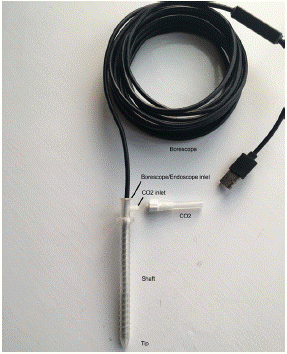
Perspective
Ann Surg Perioper Care. 2024; 9(1): 1063.
Novel Laparoscopic Access Device (LAD)
George Alex, MBBS, MRCS, Ed MCh*
Department of Surgery Jiwan Jyoti Christian Hospital Robertsganj Sonbhadra District Uttar Pradesh India
*Corresponding author: George Alex Department of Surgery Jiwan Jyoti Christian Hospital Robertsganj Sonbhadra District Uttar Pradesh India. Email: drgeorgealex@doctors.org.uk
Received: December 13, 2023 Accepted: January 17, 2024 Published: January 22, 2024
Perspective
A large of complications to do with laparoscopic surgery have to do with laparoscopic access1. The current common modes of access include the Open Hasson, Closed Veress needle, and Optical Trocar techniques. These are known to be associated with the following risks and disadvantages:
1. The Open Hasson technique - risk of air leak [2]
2. Veress Needle - risk of injury to intra-abdominal structures owing to it being a “blind” procedure [3,4]
3. Optical trocar - risk of injury to intra-abdominal structures as tip not completely blunt respectively [5]
The Novel Laparoscopic Access Device seeks to provide a safe mode of laparoscopic entry.
Novel Laparoscopic Access Device – Parts
• Tip - Completely blunt i.e. hemispherical hence lesser risk of injury to intra-abdominal structures. Has openings to let in insufflating gas i.e. CO2
• Shaft - Has spirals/threads starting well away from tip. Diameter can be as small as the smallest available borescope/endoscope i.e. 1mm
• Proximal End (External) - Has 2 openings; one to put in endoscope and other for insufflation.
Novel Laparoscopic Access Device – Features
• Tiny incision lessening risk of air leak

Figure 1: Novel Laparoscopic Access Device with Borescope in situ.
• Introduction by screwing motion rather than direct pressure
• Direct Visualisation of abdominal wall layers and intra-abdominal structures
• Has a blunt tip reducing risk of injury to intra-abdominal structures?
• Mode of creating Pneumoperitoneum
• Facilitates introduction of other ports under direct vision
• The device is not just limited to use in the abdomen but can be used elsewhere e.g. Orthopaedic (joint) operations, End0crine (Thyroid) operations etc.
Novel Laparoscopic Access Device – Mode of use
1. Make a small skin incision as required site e.g. periumbilical region.
2. Introduce a lighted borescope/endoscope into theNovel Laparoscopic Access Device.
3. Introduce the Device by gentle but firm screwing motion through the abdominal wall and into the peritoneal cavity with direct visualisation
4. Once the tip is inside the peritoneal cavity as confirmed by visualisation of intra-abdominal structures, connect the gas tubing to the device and start insufflation.
5. Once sufficient pneumoperitoneum has been achiev-ed, other ports can be introduced with direct visualisation in other parts the abdomen.
6. The same or a larger endoscope can be now introduced through any of the other ports whose distal ends are open for carrying on with the operative procedure.
7. The Novel Laparoscopic Access Device can continue to be used for gas insufflation.
The device can be manufactured either for single use or as a reusable product. Recommended material of production could be but is not limited to Clear Polycarbonate.
References
- Munro MG. Laparoscopic access: complications, technologies, and techniques. Curr Opin Obstet Gynecol. 2002; 14: 365-74.
- Chotai NR, Choksi BB, Damor S, Bhedi A. ’Intraperitoneal access by closed method (veress needle) versus open (Hasson’s) method in laparoscopic surgery to create pneumoperitoneum.’ International. Surg J. 2017; 4: 2786-90.
- Daemen JHT, Deden LN, van den Ende A, Pijl MEJ, Slump CH, Berends FJ, et al. A novel abdominal wall entry suction device to increase Veress needle safety: A prospective cohort pilot study. Ann Med Surg (Lond). 2019; 47: 70-4.
- Agresta F, De Simone P, Ciardo LF, Bedin N. Direct trocar insertion vs Veress needle in nonobese patients undergoing laparoscopic procedures: a randomized prospective single-center study. Surg Endosc. 2004; 18: 1778-81.
- Sharp HT, Dodson MK, Draper ML, Watts DA, Doucette RC, Hurd WW. Complications associated with optical-access laparoscopic trocars. Obstet Gynecol. 2002; 99: 553-5.